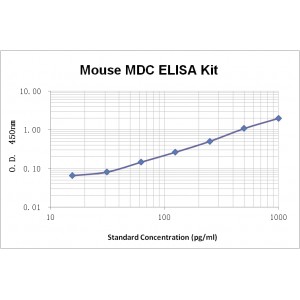More info
Assay Range | 15.6-1,000 pg/mL |
Sensitivity | 1.0 pg/mL |
Size | 96T |
Storage | Store at 2 - 8ºC. Keep reconstituted standard and detection Ab at -20 ºC |
Assay Principle | Sandwich ELISA |
Sample Volume | 100 µL final volume, dilution factor varies on samples |
Detection Method | Chromogenic |
Kit Components
1. Recombinant Mouse MDC standard: 2 vials
2. One 96-well plate coated with Mouse MDC Ab
3. Sample diluent buffer: 12 mL - 1
4. Detection antibody: 130 µL, dilution 1:100
5. Streptavidin-HRP: 130 µL, dilution 1:100
6. Antibody diluent buffer: 12 mL x1
7. Streptavidin-HRP diluent buffer: 12 mL x1
8. TMB developing agent: 10 mL x1
9. Stop solution: 10 mL x1
10. Washing solution (20x): 25 mL x1
Background
Macrophage-derived chemokine (MDC), also known as C-C motif chemokine 22 (CCL22), CC chemokine STCP-1, small-inducible cytokine A22, or stimulated T-cell chemotactic protein 1, is a member of the CC chemokine family. MDC is a 69 amino acid small chemokine. It shares less than 35% sequence identity with other human chemokines and is 65% identical to the apparent mouse homolog, ABCD-1 (Activated B cell and dendritic cell-1). Mouse MDC gene encodes a 92 amino acid (aa) precursor that has a 24 aa signal sequence and a 68 aa mature MDC protein with four conserved cysteine residues forming two intrachain disulfide bonds, a C-terminal heparin-binding motif. Mature mouse MDC shares 65% and 88% aa sequence identity with mature human and rat MDC, respectively. Interestingly, mouse MDC is 32% aa identical to mouse CCL17/TARC, the only known other chemokine that serves as a ligand for CCR4, the sole MDC receptor identified so far. MDC is constitutively expressed in dendritic cells, B lymphocytes, and macrophages, while it is inducible in NK cells, monocytes, and CD4+ T lymphocytes in response to stimuli of IL-4 and IL-13. MDC is a ligand for the G protein-coupled chemokine receptor CCR4. MDC exhibits chemotactic activity in macrophages and dendritic cells which show little or no CCR4 expression, suggesting that alternate receptor(s) occur.


